Podcast: Play in new window | Download
Subscribe: Apple Podcasts | RSS
 The year is 1944. Andrews Sisters tunes blare over the shady coconut groves on a small Pacific atoll. The boys in service of America’s war effort have just completed 3 runways capable of handling the massive B-29 Superfortresses that would land there and would help win the war. The clean-cut young American servicemen building this secret base designated “Island X” were mildly curious of the ruins that they found on this remote island when they arrived. None of them knew of the drama that played out there just a quarter of a century before, or of the people who were born or died there.
The year is 1944. Andrews Sisters tunes blare over the shady coconut groves on a small Pacific atoll. The boys in service of America’s war effort have just completed 3 runways capable of handling the massive B-29 Superfortresses that would land there and would help win the war. The clean-cut young American servicemen building this secret base designated “Island X” were mildly curious of the ruins that they found on this remote island when they arrived. None of them knew of the drama that played out there just a quarter of a century before, or of the people who were born or died there.
Island X has had many other names in its long history. Located 670 miles southwest of the coast of Mexico in the eastern Pacific, this remote island was discovered in 1526 by a Spanish sea captain named Alvaro de Saavedra and he named it La Isla de Mídanos. There was no evidence of any previous habitation, as it was hundreds and hundreds of miles from the nearest land. It remained on nautical charts with the name Mídanos for many years and starting in 1576 was an important marker on the Manila to Acapulco galleon route linking the colony of New Spain with the Spanish Philippines. In the 18th Century the island appeared on English maps as Clipperton Island, named after an English pirate who visited the island in 1705. Two French ships arrived in 1711 and named the island Ile de la Passion, or Passion Island. In Spanish it would be known henceforth as Isla de la Pasión although Clipperton Island would be used interchangeably. Today it is known as Clipperton.
 The many name changes of the island showed the conflicting claims to Clipperton and various interests that the island was subject to. In the 1840s in a Pacific offshoot of Manifest Destiny, many uninhabited islands in the Pacific Ocean were claimed by the United States or at least had economic activities on them directed by US companies. Clipperton had attracted the attention of companies interested in extracting the hardened bird droppings, or guano, used in making fertilizer and gunpowder. In 1856 the US enacted the Guano Islands Act and the first part of this act reads:
The many name changes of the island showed the conflicting claims to Clipperton and various interests that the island was subject to. In the 1840s in a Pacific offshoot of Manifest Destiny, many uninhabited islands in the Pacific Ocean were claimed by the United States or at least had economic activities on them directed by US companies. Clipperton had attracted the attention of companies interested in extracting the hardened bird droppings, or guano, used in making fertilizer and gunpowder. In 1856 the US enacted the Guano Islands Act and the first part of this act reads:
“Whenever any citizen of the United States discovers a deposit of guano on any island, rock, or key, not within the lawful jurisdiction of any other Government, and not occupied by the citizens of any other Government, and takes peaceable possession thereof, and occupies the same, such island, rock, or key may, at the discretion of the President, be considered as appertaining to the United States.”
 The French were aware of American activities on the island because of its proximity to French Polynesia, notably the Marquesas and Tahiti, and sought to exercise is claim on Clipperton. On November 17, 1858, a French expedition anchored offshore and read a proclamation that declared the island belonged “to his Majesty the Emperor Napoleon III, his heirs and successors in perpetuity.” A French guano mining operation landed there 2 years later and declared the island not worth anything. A few years later the American Agricultural Chemical Company, with its brand Red Dragon Guano, arrived on the island and started a small operation, but as with other schemes, this one was short-lived. Dreams of guano fortunes would be rekindled in 1893 when a San Francisco company would declare the resources on the island to be worth 50 million dollars, raised capital, and started operations on Clipperton. 100 men, mostly Italian and Japanese immigrants who lived in San Francisco, mined the guano, built a small railroad and constructed a dock. In a few years, with money running out, this venture was bought out by the British Pacific Islands Company which continued to mine the guano.
The French were aware of American activities on the island because of its proximity to French Polynesia, notably the Marquesas and Tahiti, and sought to exercise is claim on Clipperton. On November 17, 1858, a French expedition anchored offshore and read a proclamation that declared the island belonged “to his Majesty the Emperor Napoleon III, his heirs and successors in perpetuity.” A French guano mining operation landed there 2 years later and declared the island not worth anything. A few years later the American Agricultural Chemical Company, with its brand Red Dragon Guano, arrived on the island and started a small operation, but as with other schemes, this one was short-lived. Dreams of guano fortunes would be rekindled in 1893 when a San Francisco company would declare the resources on the island to be worth 50 million dollars, raised capital, and started operations on Clipperton. 100 men, mostly Italian and Japanese immigrants who lived in San Francisco, mined the guano, built a small railroad and constructed a dock. In a few years, with money running out, this venture was bought out by the British Pacific Islands Company which continued to mine the guano.
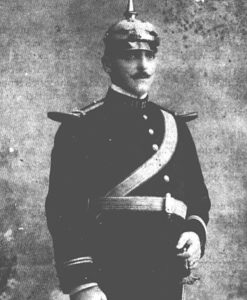 In Mexico, President Porfirio Diaz had heard about the activities on Clipperton and he and many Mexicans had considered the island part of Mexican territory citing claims going back to the 16th Century. Diaz reasoned that when Mexico gained independence from Spain in 1810 that this territory became part of the new nation of Mexico because it was once Spanish territory in the sphere of New Spain. In December of 1897 Diaz sent a gunboat, La Democrata, to occupy and annex the island. In the following year in Mexico City, Mexican Foreign Minister Ignacio Mariscal met with Arthur Hamilton-Gordon, the First Baron Stranmore, an English nobleman who was chairman of the British Pacific Islands Company. They drew up an agreement and Mexico bought the guano rights to the island for 20 years. The Mexican government’s plan was to buy the rights, set up a colony and then stake a legitimate territorial claim to Clipperton. No one really knows the motivation behind Porfirio Diaz’ desire to possess the island. Was it a political distraction? Was it a way to foster national pride in a greater Mexico? His reasons are not clear to this day.
In Mexico, President Porfirio Diaz had heard about the activities on Clipperton and he and many Mexicans had considered the island part of Mexican territory citing claims going back to the 16th Century. Diaz reasoned that when Mexico gained independence from Spain in 1810 that this territory became part of the new nation of Mexico because it was once Spanish territory in the sphere of New Spain. In December of 1897 Diaz sent a gunboat, La Democrata, to occupy and annex the island. In the following year in Mexico City, Mexican Foreign Minister Ignacio Mariscal met with Arthur Hamilton-Gordon, the First Baron Stranmore, an English nobleman who was chairman of the British Pacific Islands Company. They drew up an agreement and Mexico bought the guano rights to the island for 20 years. The Mexican government’s plan was to buy the rights, set up a colony and then stake a legitimate territorial claim to Clipperton. No one really knows the motivation behind Porfirio Diaz’ desire to possess the island. Was it a political distraction? Was it a way to foster national pride in a greater Mexico? His reasons are not clear to this day.
Mexican officials were dispatched to Clipperton to oversee the guano mining but it wasn’t until 1906 when President Porfirio Diaz ordered a permanent Mexican garrison and civilian colony to be established on the island. The first governor of the colony was Ramon Arnaud, a captain in the Mexican army who was born in Orizaba, Veracruz to immigrants from France who went to Mexico during the reign of the Habsburg ruler of Mexico, Emperor Maximilian. Ramon Arnaud was stationed in the Yucatan fighting Maya insurgents during the Caste Wars and after a brief secret mission to Japan he was given the post of governor. Before he embarked on his new post, the 29-year-old dashing military officer married the beautiful Alicia Rovira who was excited to be the consort in this colonial adventure. Alicia’s enthusiastic attitude changed soon after arriving on the island.
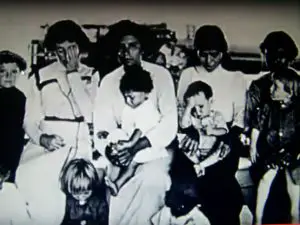 Conditions on Clipperton were harsh. The skeleton crew of the mining operation was still there and there was little for the 21 colonists to do outside of building the lighthouse commissioned by Porfirio Diaz and making other minor improvements to the island. Within a year, the first child was born on the island, the first son of Ramon and Alicia Arnaud. They named him Ramon, or Ramoncito. By 1910 all guano mining operations were abandoned. By then the good deposits had already been mined and it was too labor-intensive to refine the remaining deposits. Most of the miners left, with only one German man, Gustav Shultz, staying behind. During this time the Mexican Revolution was underway back home and Porfirio Diaz was deposed. The supply ships to Clipperton stopped and the colonists were left to their own devices, cut off from the outside world and seemingly forgotten by Mexico which had other concerns. The islanders subsisted on mostly seafood, land crabs, birds and bird eggs. The coconut groves on the islands produced 3 coconuts every six months per tree and this was not enough vitamin C for the islanders. Slowly, the colonists came down with scurvy and a few died. An American ship ran aground in February of 1914 and was so appalled at the conditions they saw at the Clipperton colony, they took their lifeboat to Acapulco and pleaded for assistance from the Mexicans. The
Conditions on Clipperton were harsh. The skeleton crew of the mining operation was still there and there was little for the 21 colonists to do outside of building the lighthouse commissioned by Porfirio Diaz and making other minor improvements to the island. Within a year, the first child was born on the island, the first son of Ramon and Alicia Arnaud. They named him Ramon, or Ramoncito. By 1910 all guano mining operations were abandoned. By then the good deposits had already been mined and it was too labor-intensive to refine the remaining deposits. Most of the miners left, with only one German man, Gustav Shultz, staying behind. During this time the Mexican Revolution was underway back home and Porfirio Diaz was deposed. The supply ships to Clipperton stopped and the colonists were left to their own devices, cut off from the outside world and seemingly forgotten by Mexico which had other concerns. The islanders subsisted on mostly seafood, land crabs, birds and bird eggs. The coconut groves on the islands produced 3 coconuts every six months per tree and this was not enough vitamin C for the islanders. Slowly, the colonists came down with scurvy and a few died. An American ship ran aground in February of 1914 and was so appalled at the conditions they saw at the Clipperton colony, they took their lifeboat to Acapulco and pleaded for assistance from the Mexicans. The  provisional revolutionary government denied any help. This is where the US Navy stepped in. The commander of a US Navy ship in Acapulco at the time had heard of the islanders’ plight and decided to mount a rescue operation of his own. When the ship arrived at the island, Governor Arnaud refused to give up his post and refused evacuation. The last remaining guano miner, the German named Schultz, left on the US Navy ship. The ship
provisional revolutionary government denied any help. This is where the US Navy stepped in. The commander of a US Navy ship in Acapulco at the time had heard of the islanders’ plight and decided to mount a rescue operation of his own. When the ship arrived at the island, Governor Arnaud refused to give up his post and refused evacuation. The last remaining guano miner, the German named Schultz, left on the US Navy ship. The ship 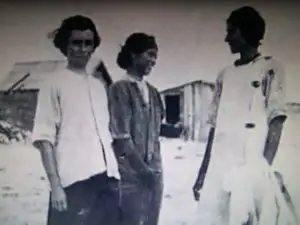 left behind 5 months’ worth of provisions to keep the colony afloat until the political situation on the Mexican mainland sorted itself out. By then there were 6 children on the island, all born there, 6 women and 15 remaining men, mostly Mexican army. When the colonists waved good-bye to the US ship, they had no idea that the next ship to stop and take notice would be 3 years into the future.
left behind 5 months’ worth of provisions to keep the colony afloat until the political situation on the Mexican mainland sorted itself out. By then there were 6 children on the island, all born there, 6 women and 15 remaining men, mostly Mexican army. When the colonists waved good-bye to the US ship, they had no idea that the next ship to stop and take notice would be 3 years into the future.
They did see a ship the next year on May 5th 1915. Because some colonists had recently died of scurvy, Arnaud felt that it was time to abandon the colony. All able-bodied men on the island except one got into a small boat to try to go out and flag down the ship. Clipperton’s choppy surf and dangerous reefs are often very hard to navigate. The boat never made it out to the passing ship. It capsized and all hands were lost. Ramon Arnaud would be the first and last governor of the colony of La Isla de la Pasión.
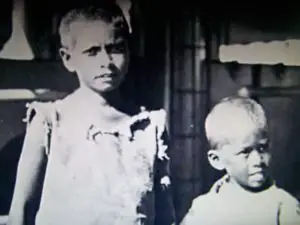 This is where the story takes a certain Lord of the Flies twist but without Ralph or Piggy. As the sole remaining man on the island, the lighthouse keeper, Victoriano Alvarez, declared himself the King of Passion Island and began issuing proclamations fitting of his title. Notably, Alvarez declared that all the women on the island were his property and he could have his way with any one of them as he wished. When he commanded that a 15-year-old girl live with him in his shack at the base of the island’s volcano, the girl’s mother refused. Alvarez killed them both. The rest of the women and children, now numbering 10, lived in fear of Alvarez who issued declarations and forced them to do things at will. The high hopes of the young bride of the dashing Mexican colonial governor had turned to secret plots with the other women, and Alicia Arnaud eventually vowed to kill Alvarez. In July of 1917 the lighthouse keeper entered the hut of familia Arnaud and proclaimed that Alicia Arnaud would live with him and she had a few days to prepare. On the morning of July 18, 1917, fellow colonist Tirza Rendon went to Alvarez’ home along with Alicia and little Ramoncito who was 9 years old at the time. Alvarez was surprised and told them to leave, at which time Tirza Rendon grabbed a hammer and hit the lighthouse keeper in the head. The blow knocked him down, but he got up and came after Alicia with an axe. Tirza hit him again as Alicia yelled at little Ramon to leave, and to take the guns with him. When little Ramon left the hut, to his surprise he saw a large ship very near to shore. Excited, he ran back into the lighthouse keeper’s shack to announce the news. The little boy was met with a grisly scene, the battered body of Victoriano Alvarez dead on the floor. The women left the shack and called the other colonists to the shore to get the attention of the passing ship.
This is where the story takes a certain Lord of the Flies twist but without Ralph or Piggy. As the sole remaining man on the island, the lighthouse keeper, Victoriano Alvarez, declared himself the King of Passion Island and began issuing proclamations fitting of his title. Notably, Alvarez declared that all the women on the island were his property and he could have his way with any one of them as he wished. When he commanded that a 15-year-old girl live with him in his shack at the base of the island’s volcano, the girl’s mother refused. Alvarez killed them both. The rest of the women and children, now numbering 10, lived in fear of Alvarez who issued declarations and forced them to do things at will. The high hopes of the young bride of the dashing Mexican colonial governor had turned to secret plots with the other women, and Alicia Arnaud eventually vowed to kill Alvarez. In July of 1917 the lighthouse keeper entered the hut of familia Arnaud and proclaimed that Alicia Arnaud would live with him and she had a few days to prepare. On the morning of July 18, 1917, fellow colonist Tirza Rendon went to Alvarez’ home along with Alicia and little Ramoncito who was 9 years old at the time. Alvarez was surprised and told them to leave, at which time Tirza Rendon grabbed a hammer and hit the lighthouse keeper in the head. The blow knocked him down, but he got up and came after Alicia with an axe. Tirza hit him again as Alicia yelled at little Ramon to leave, and to take the guns with him. When little Ramon left the hut, to his surprise he saw a large ship very near to shore. Excited, he ran back into the lighthouse keeper’s shack to announce the news. The little boy was met with a grisly scene, the battered body of Victoriano Alvarez dead on the floor. The women left the shack and called the other colonists to the shore to get the attention of the passing ship.
The ship was the USS Yorktown. The American naval vessal was on maneuvers as part of its duties connected with World War I, specifically, it was searching the small islands of the Pacific for Germans who were hiding out. The captain of the Yorktown described the haggard condition of the colonists: children were wearing clothes made of sailcloth or old flour bags and it was clear that 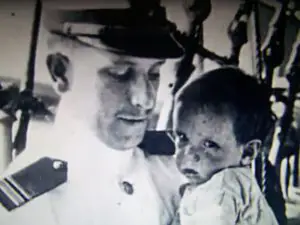 everyone was malnourished and distressed. The Yorktown sailed into the port of Acapulco on July 21, 1917, and family members were waiting for the islanders. The news in Mexico had said that the colonists had perished, so the reunion on the Mexican mainland was a joyous one.
everyone was malnourished and distressed. The Yorktown sailed into the port of Acapulco on July 21, 1917, and family members were waiting for the islanders. The news in Mexico had said that the colonists had perished, so the reunion on the Mexican mainland was a joyous one.
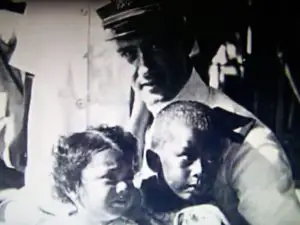 After the colonists returned to the mainland sensational stories circulated in the press as to what happened on the island, especially in connection with the death of Captain Arnaud. Stories said that his small boat was attacked by a huge manta ray or octopus. There were also stories of cannibalism that were not true, and plots involving German and French intrigue. In the 1930s there was a movie made in Mexico called La Isla de la Pasión in which the main protagonist, played by Mexican film star Pedro Amendáriz, fights off an attack by French gunboats that arrived to take over the Mexican colony. At the same time of the movie’s release, the ultimate fate of the island was decided. In Porfirio Diaz’ time, the president had asked the king of Italy, Victor Emmanuel the Third to arbitrate the dispute over Clipperton between the Mexicans and the French, agreeing to be bound by the king’s decision. The king decided in 1931 that the island was French territory
After the colonists returned to the mainland sensational stories circulated in the press as to what happened on the island, especially in connection with the death of Captain Arnaud. Stories said that his small boat was attacked by a huge manta ray or octopus. There were also stories of cannibalism that were not true, and plots involving German and French intrigue. In the 1930s there was a movie made in Mexico called La Isla de la Pasión in which the main protagonist, played by Mexican film star Pedro Amendáriz, fights off an attack by French gunboats that arrived to take over the Mexican colony. At the same time of the movie’s release, the ultimate fate of the island was decided. In Porfirio Diaz’ time, the president had asked the king of Italy, Victor Emmanuel the Third to arbitrate the dispute over Clipperton between the Mexicans and the French, agreeing to be bound by the king’s decision. The king decided in 1931 that the island was French territory  based on the 1711 “discovery” and the 1858 formal declaration by the French emperor. In 1932 the Mexican Congress ratified the declaration and gave up all territorial claims to Clipperton Island.
based on the 1711 “discovery” and the 1858 formal declaration by the French emperor. In 1932 the Mexican Congress ratified the declaration and gave up all territorial claims to Clipperton Island.
The saga of the Mexican colony of Isla de la Pasión has a curious footnote. 6 decades later, little Ramoncito Arnaud, the first person to be born on the island, returned to Clipperton on an expedition led by French oceanographer and adventurer Jacques Cousteau. Most of the evidence of Mexican habitation had long since gone but surprisingly Arnaud’s memory was very clear. Besides the brief American presence during World War Two there has been no permanent settlement on the island since the doomed Mexican colony. The island was attached to French Polynesia for many years until 2007 when it reverted to the direct control of the Minister of Overseas France. The French have no current plans for an island  that they never really controlled or inhabited. Clipperton has been left to the terns, the crabs and the ghosts of the unfortunate Mexican colonists.
that they never really controlled or inhabited. Clipperton has been left to the terns, the crabs and the ghosts of the unfortunate Mexican colonists.
REFERENCES (This is not a formal bibliography):
Clipperton, Isla Mexicana by Miguel Gonzalez Avelar (in Spanish)
Isla de la Pasión by Victor Hugo Rascón Banda (in Spanish)
Clipperton. A History of the Island the World Forgot by Jimmy Skaggs
Jacques Cousteau’s documentary, “Clipperton: The Island that Time Forgot” (1978)
